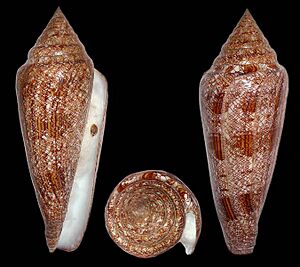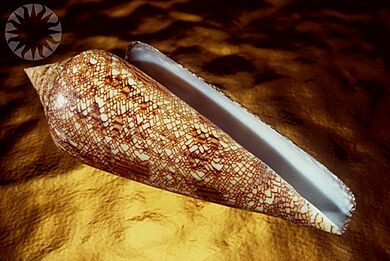Conus gloriamaris facts for kids
Quick facts for kids Conus gloriamaris |
|
|---|---|
 |
|
| Conus gloriamaris | |
| Conservation status | |
| Scientific classification | |
| Synonyms | |
|
The Conus gloriamaris, often called the Glory of the Sea Cone, is a type of sea snail. It's a marine gastropod mollusk that belongs to the Conidae family. This family includes all the cone snails, which are known for their beautiful, cone-shaped shells. You can usually find the Glory of the Sea Cone in the warm waters of the Pacific Ocean and Indian Ocean.
Contents
What Does the Glory of the Sea Cone Look Like?
The shell of the Glory of the Sea Cone can grow up to 16 centimetres (6.3 in) long. That's about the length of a large smartphone! Most shells are usually between 8 and 12 centimetres (3.1 and 4.7 in).
Compared to other cone snails, this one is quite large and slender. It has a tall, pointed top part called a spire. Its shell has fine orange-brown lines that create triangular patterns. It also has two or three bands of chestnut-colored markings across its body.
The Glory of the Sea Cone can sometimes be confused with other similar shells. Its tan color can change from a light, golden shade to a deeper dark brown. Each shell has very detailed and beautiful patterns.
Why Was This Shell So Special to Collectors?
The shell of the Glory of the Sea Cone has a very interesting history for shell collectors. For a long time, it was thought to be the rarest shell in the entire world!
For about 200 years, after it was first discovered, finding one of these shells was incredibly difficult. Because they were so rare, specimens were worth thousands of U.S. dollars. Usually, only museums or very rich private collectors could own one.
There were even famous stories about its rarity. One legend says that in 1792, a collector bought a Glory of the Sea shell at an auction. Then, he supposedly destroyed it! He did this to make sure the other Glory of the Sea shell he already owned would stay super valuable.
However, things changed after 1969. New diving technology, like scuba gear, helped people explore deeper parts of the ocean. Divers started finding more of these shells. Because more shells were found, their value dropped. Today, you can often find them online or from retailers for less than $100 U.S.
Even though they are not as rare or expensive now, the Glory of the Sea Cone is still very popular. Its history, along with its pleasing shape and beautiful patterns, makes it a favorite among shell collectors.
Where Do Glory of the Sea Cones Live?
The Glory of the Sea Cone is one of many cone snail species found in the Indo-Pacific region. This means it lives in the warm waters of the Indian Ocean and the western Pacific Ocean.
You can find them mainly off the Solomon Islands. Their habitat stretches from the Philippines and eastern Indonesia, through New Guinea, and as far east as Samoa and Fiji.
Gallery






